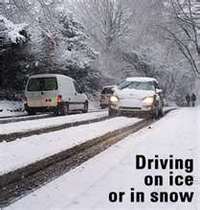Fremont Insurance Offers Tips for Safe Winter Driving
 |
FREMONT, MI--February 24, 2012: Icy road conditions and unsafe driving practices lead to thousands of crashes each year. In fact, according to the Michigan Office of Highway Safety Planning, nearly 80,000 crashes in Michigan last year were the result of wet, icy and snowy road conditions. Fremont Insurance, a Michigan-exclusive property and casualty insurance carrier with headquarters in Fremont, Michigan, wants to help Michigan drivers stay safe and avoid costly accidents.
"Winter driving in Michigan provides every kind of driving condition, wet to slick to snow-covered roads and downpours to white outs creating scary conditions for people of all ages, skill levels and driving experience," said Kurt Dettmer, vice president and chief marketing officer for Fremont Insurance. "While many driving tips are things Michigan drivers have heard before, it's always a good idea to stop and think about them again before heading out on the road."
Fremont Insurance offers these 10 Safety Tips for Winter Driving to help Michigan drivers arrive safely and avoid costly accidents.
- Start Clean -- Be sure to completely clear snow and ice from all windows, lights, hood and roof for maximum visibility and to avoid having ice and snow fly off your vehicle. Law enforcement officials are on the lookout for "peephole drivers."
- Light it Up -- Before starting out, turn on your lights to increase your visibility to other motorists.
- Slow it Down -- Remember, posted speed limits are for dry pavement. Decrease speed on icy, snow-covered roads and allow extra distance between you and other vehicles.
- Look Ahead -- Watch the traffic well ahead for extra reaction time. Always drive defensively and give yourself a cushion of time to deal with wintery conditions.
- Stay Away -- Stay well back of maintenance vehicles and snowplows -- at least 200 feet (it's the law) -- and don't pass on the right. Use extreme caution when passing in a passing lane.
- Pick a Lane -- Avoid abrupt lane changes. There may be a snow ridge between lanes. Also, the passing lane may be in worse shape than the driving lane.
- Take a Brake -- Brake early and gently to avoid skidding. It takes more time and distance to stop in adverse conditions. If your wheels start to lock up, ease off the brake. Do not pump anti-lock brakes. The right way is to stomp and steer.
- Watch for Signs -- Watch for signs alerting you to slippery bridge decks and other areas prone to becoming slick, even when the rest of the pavement is in good condition.
- Stay in Control -- Don't use cruise control or overdrive in wintery conditions. Even a slight depression of your brakes to deactivate can cause loss of control on hidden slippery patches
- Avoid Assumptions -- Do not assume your vehicle can handle all conditions. Even four-wheel and front-wheel drive vehicles encounter trouble on winter roads. The false sense of security these vehicles offer can leave you less prepared to deal with emergency situations.
"Sometimes the best idea is to just stay home and avoid adverse conditions completely," advises Dettmer. "However, if that's not an option, the best advice would be to simply slow down. It seems like everyone is in a hurry to get somewhere these days, but always remember that it's better to arrive a few minutes late and be safe than to drive too fast for conditions and not arrive at all."


